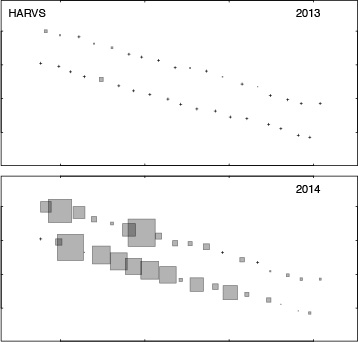Harvard Forest (HARV)
-72.258 W, 42.424 N
seed trap establishment: June 2018
Jordan Luongo, Zoe Davis
seed collection and crop count:
June 2019- Jordan Luongo, Lane Scher

Sampling at Harvard Forest includes long term plots established by our lab in 2012 and new efforts located at NEON plots. The long-term plots, HARV-BW and HARV-S, are 1-ha in area, both supporting a canopy of conifers and northern hardwoods. Maps here show distributions of trees in the genus Betula and seed collections in a mast and a non-mast year.

The HARV NEON site is located on the Quabbin Reservoir, one of the primary water supplies for Boston. This area is strictly managed by the Massachusetts Department of Conservation and Recreation. This large, protected watershed harbors northern hardwood forests and diverse wildlife.
With help from domain manager, Kristin Godfrey, and Senior Ecologist, Greta VanScoy, we established sampling at nine NEON plots.
Plot 5 is located in a dense bottom-land forest. Dominant tree species include, Acer rubrum, Quercus alba, and Quercus rubra. The midstory is dominated by Hammalis virginiana. Oaks in this plot have extensive foliar from gypsy moth, with many trees being completely defoliated. Pinus strobus was a dominant species in the past, but shows substantial understory mortality. Ground cover consists of ferns and Vaccinium.

Plot 2 is on a rocky slope, with large boulders throughout. The stand is dominated by Acer rubrum, Betula lenta, Quercus alba, and Quercus rubra. The understory has dense Pinus strobus recruitment. Hamammelis virginiana is abundant.
Plot 21 supports a dense Pinus strobus understory. The upper canopy consists of old growth Pinus strobus, Betula lenta and Acer rubrum. The eastern side of the plot has been thinned by recent beaver activity.

Plot 8 is a dense hardwood stand, dominated by Quercus rubra, Acer rubrum, and Betula lenta. The understory is dense and dominated by Betula lenta.
Plot 4 has a relatively open canopy, with scattered Pinus strobus, Fraxinus americana, Quercus rubra and Acer rubrum. The understory is dominated by Pinus strobus recruits, Hamammelis virginiana, and ferns. This plot has extensive damage from the emerald ash borer and gypsy moth, the former killing many of the Fraxinus americana trees, and the latter defoliating Quercus rubra.
Plot 1 has dense Betula lenta and Pinus strobus recruitment. The canopy consists of mature Pinus strobus, Quercus rubra, Quercus alba, Acer rubrum, Betula lenta, and Carya glabra.
Plot 10 occupies a rocky slope with a dense understory of Gaylussacia and ferns. Mature trees include Pinus strobus, Quercus rubra, Quercus alba, and Acer rubrum. The mid story consists of Pinus strobus and Betula lenta, which appear suppressed.
Plot 6 is an open stand that was once dominated by Quercus rubra and Quercus alba. Due to gypsy moth defoliation, the sparse herbaceous layer is exposed to high light levels. Other species include Acer rubrum and Picea rubens.
Plot 13 was not sampled, because the road to this stand was submerged.
Plot 22 occupies a bottom land, approximately about 100 m east of a swamp. It is dominated by Pinus strobus, with few Betula lenta and Acer rubrum trees. Most of the Pinus strobus trees smaller then 10 cm have died due to competition. The understory is open, except in the Southwest corner (dominated by Betula lenta recruits).

Below are stem maps for HARV NEON plots:











